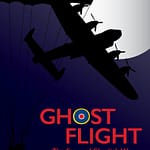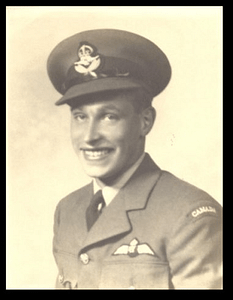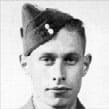

Pete Wilsher looks young in his picture but he was 2 years older than I was. He joined about the same time I did, in 1942.
Pete was part of the crowd that I knew then – he was a tremendous fellow! He was a friend and neighbour of mine from Dorval. He went to Lachine High School. Pete was an all-round athlete, a good athlete. He played every sport, football, hockey; he played everything! He was the fellow who showed me how to throw a football. He was also a good scholar. When I was ten or eleven years old he was one of the Quebec high school representatives in the 1930’s to go to Germany. He was a good student to go to Germany if you can imagine in the 1930s and then go back as a bomber pilot.

Frederick H. Wilsher
Born at Campbellford, Ontario on June 18, 1918, F.H.
Wilsher is the son of Mr. F.W. Wilsher and Mrs. Wilsher, nee Ethel Nancarrow.
He received his education at the Lachine High School
and first worked for the Shawinigan Water and Power
Co. during the summer of 1939, at Rapide Blanc. He was shift operator at the Joliette Substation, when he left for Active Service with the Royal Canadian Air Force on April 11, 1942.
His favourite sports are golf, tennis and swimming.
He joined about the same time I did, in 1942.
Sometimes I think he hung out with me because he liked my sister Frances, but she only went out with him once and that was it. It’s not fair to say that, I know, but I do wonder. Pete was closer in age to my brother but they were never that friendly.
I flew a few operations with him, he was a pilot; we were in the Lion squadron at the same time. He was a changed man from the man I knew before. There was so much stress knowing that he had to protect his crew of seven, and himself; to fly out on a mission and come back in one piece. We all had our duties to perform, but we were just passengers. It’s a terrible responsibility for the pilot and the navigator.
I flew four operations with Pete because his gunner wasn’t well or something. Then I was transferred to another squadron and he was transferred and that’s where he was killed. I don’t know exactly what happened. Being a young pilot in that too, it put a lot of stress on him.
Pete only learned how to fly before going overseas. He had to go through pilot training near St. Hubert. He graduated from pilot school in Quebec–I forget where the pilots’ school was here. When he went overseas after he had his pilot’s licence with the R.C.A.F. he had to go through more training because he flew first in small planes to twin-engine planes then on to the big airplanes like the Lancaster; that was the final step in his training. Then go onto a squadron. A fighter pilot would go through all that training but instead of going into a bomber squadron they’d go into a fighter squadron. Pete-instead of training as a fighter pilot he was trained as a bomber pilot. A lot of them wanted to be fighter pilots because there’s a lot less responsibility. You’re on a plane and you’re on your own. In a bomber, the pilot has responsibility for all those people. Looking back they were young too–he was only about two or three years older than me. I was on my own in the back, with little responsibility, except to watch for enemy aircraft and record anything that was unusual over the bombing areas. He had the responsibility of all seven of the crew–really it was an awful responsibility for a young man–it was nerve-wracking. The first pilot I had was an older man and he was a real disciplinarian–but he was killed too. Some of the pilots were already in the R.A.F. before the war and some were bush pilots–they’d been flying for years in different types of aircraft up north but Pete had no flying experience. The air force helped to decide what a person should do. There were certain criteria for a pilot.
Pete was transferred from our bomber squadron to the ones that dropped the flares, eh? What did they call it? The Pathfinders Group. The Pathfinder squadron used to go in, in advance to the blacked-out cities. The cities were blacked out because they knew we were coming at night. Prior to going into bombing they went in and dropped flares. They would have to fly low to place the flares. Pretty dangerous–flares in a big city! Maybe half an hour before us and these flares lit up the whole city. The Pathfinders flew Mosquitoes, a very fast plane made of wood. The Mosquito planes were also used as bombers doing a milk run, early every morning into Berlin.

Pete Wilsher was transferred to the 405 Vancouver Squadron, the only R.C.A.F. Squadron to be selected to be part of the R.A.F.’s Path Finder Group.

He died on December 29, 1944, with the rest of the crew in a Lancaster of the 405 Squadron. They went out on a bombing run as part of No. 6 Bomber Command instead of No. 8 Pathfinder Force. Following is the operations report of Pete Wilsher’s last flight:
“On the night of the 29th/30th Canadian squadrons despatched 64 Lancasters as part of a force of 335 heavies attacking the Hydrierwerk Scholven A. G. with No. 6 Group supplying 48 and the Vancouver Pathfinders another sixteen. This synthetic oil plant, situated north of Buer and 7½ miles northwest of Gelsenkirchen, had an annual capacity of 350,000 tons of oil products. Target indicators were well concentrated and bombing was accurate. One particularly large explosion shot flames up through the low 10/10ths cloud and a column of thick black smoke rose two miles in the air. The main concentration fell on the north-east section of the plant, inflicting severe damage to the main storage tanks and, in addition to fresh damage to the cooling plant and railway tracks, results of the visit were evident throughout the whole establishment. Defences were moderate, consisting of heavy flak and a few enemy fighters, but R.C.A.F. losses were heavy as three crews of long experience did not return. F/Os F. H. Wilsher, G. G. Fox, J. M. Phillips and H. R. Dryer, P/Os E.R. Kaesmodel, D. J. MacFarlane and A. W. Haley and Sgt. T. R. Harrigan of the Vancouver Squadron made up one crew. The other two were from the Moose Squadron. P/O R. F. Adam, captain of one, had WOs L. P. Wakely, F. S. Dennis and R. G. Rogers, FSs J. C. Rhind and H. C. Tarzwell and Sgt. R. E. Eratt (R.A.F.) with him, while the other was manned by F/Os R. A. McVicar and V. A. Sorrenti, FSs C. R. Conley, W. G. E. Morgan, T. J. Maloney and W. R. McLeod and Sgt. J. Feldman.”
Quote from pages 89, 90 of the R.C.A.F Overseas, The Sixth Year, Vol. 3
While I was compiling Charlie’s WWII experience I couldn’t figure out why I didn’t find any trace of Peter Wilshire in the archival records. Then in May 2015, Charles wanted Norbert’s service record. From the Archives Canada website, I downloaded Norbert Roche’s R.A.F./R.C.A.F. service record, all four hundred and sixty-two pages. In the file is a letter from Wing Commander Gunn in response to a letter from Charlie’s father in the nineteen-fifties about Pete Wilshire. The commander answered back that the only Wilshire from Dorval in the Royal Canadian Air Force was named Frederick Wilsher. Wilsher is an ancient name that spans way back in time from Germany into Great Britain and there are many variations of the name. Charles and his family had always known him as Peter Wilshire but his name was really Frederick Harold Wilsher. Charles thinks that for some reason while at Lachine High School Frederick had re-named himself, Peter. Peter’s father was also named Frederick. Peter’s last name was wrong, there were news clippings from the nineteen forties that give his name as Wilshire and the City of Dorval re-named a street to Wilshire in his memory. I don’t know why the city didn’t double-check the spelling. Charles told me that Pete’s parents died in the nineteen fifties, exactly how and when is unknown. The city document says: “from the name of an Aviator who died during the last War.”
The City of Dorval Archives gave me a document about street name changes in 1955. There was a street re-named Wilshire Avenue, in honour of Pete Wilshire (Frederick Wilsher), which still exists today. It was a surprise to also find out that another street was re-named Roche Avenue, in memory of Charles’s older brother Norbert. Roche Avenue no longer exists, if it existed at all. The Dorval archivist couldn’t find the original street, named Jolicoeur, or Roche Avenue.

I checked the Government records of the war dead for Pete’s file but so far they have no online service record or genealogy for him. He is listed on the Canadian Virtual War Memorial. Peter/Frederick has no known grave so his name is on the Runnymede Memorial, Surrey, United Kingdom; panel 248
Before the Pathfinders were formed bombers often had problems locating targets. Daylight bombing by sight was hampered by bad weather, flak from the Germans, who eventually developed radar, or the bombers were seen in advance before they could reach their target. Early on the R.A.F. did have an optical instrument called ‘Course Setting Bomb Sight’.
In 1940 R.A.F. Bomber Command decided to try night bombing. The problems were the same, perhaps even worse since cities adopted blackouts. About one aircraft out of ten came close to bombing their chosen target. The German Luftwaffe was also unable to hone in on a specific target. The Luftwaffe solved the problem first by having a select group use radio aids. This trained group would drop flares, allowing the bombers that followed them to see the target. The British developed their own specialized group called the Pathfinders.

At first with the Pathfinder Group, it was still a hit and miss operation. Finally, bombing aids were developed like Gee, Oboe and H2S Radar. It still took the Pathfinders some time to refine their technique. The group then split into three specialized units. A Christmas tree idea was developed. The first two airplanes lit the path to the sight with white target illuminators, about the same idea as lighting a path or a driveway with small lights. The path was far away along the route. Then the Illuminators used red flares around the target. The third group used coloured markers to drop incendiary bombs which caused fires that would last long enough for the bomber squadron to reach the target. The Germans soon caught on and set decoy fires with the same colours. The Pathfinders persevered and finally succeeded. With new aircraft and newer navigation and bombing aids the Pathfinders used ‘sky marking’; dropping flares by parachute, which was effective, even in bad weather. Finally, the new Lancasters had high-frequency radio and a system of ‘Master Bomber’ was created. The Master Bomber was able to communicate with the Pathfinders to mark the target.
Some Personal Memories of an RCAF Observer/Navigator: Brief Notes on the Navigation Aids Used:
“Primary was GEE, a pulsing radar system from two different locations in England. This showed as a blip on the radar screen in front of the Observer which could be plotted on a chart. Very accurate up to about 150 miles, after which the beam spread was too wide to be accurate. It was subject to heavy “jamming” by the Germans, and it was difficult to keep track of the true “blip” when dozens of false ones were also showing.
H2S – A self-contained scanning radar. It consisted of three parts, a generator driven by the starboard outer engine, a rotating radar emitting and receiving scanner mounted in a pod under the aircraft, and a Plan Position Indicator, a cathode ray tube, in front of the Observer. The scanner rotated once per second, and reflected from buildings, etc. directly below and forward of the aircraft. The scan remained on the screen long enough to be updated by the next rotation. No reflection was received over water, but the coastline could be identified, as could reflections from towns and villages along the route. From these, a bearing and distance could be calculated and plotted, and this would be passed to the Plotter for his use in determining course, wind velocity and ground speed, which info he would pass up to the pilot with any changes required to keep us on track.
Loran was a long range version of GEE developed by the Americans. It took time to get a “fix” and was not accurate enough to be used for bombing.
Every Pathfinder station had two squadrons, 1 equipped with up to 25 Lancasters, the second equipped with about 7 Mosquitoes. These Mosquitoes were equipped with a later form of radar named “OBOE.” This was a line of sight radar aimed directly at the target, with a signal system on board that alerted the pilot if he got off course. When the target was reached a separate signal was sent to indicate when the flares should be dropped. A report says that it was recently tested with a modern RAF fighter-bomber, and it could not be duplicated.”
http://www.bombercommandmuseum.ca/s,curriestory.html,
by F/O Donald M. Currie, RCAF, 635 Squadron, RAF (PFF)
http://www.bombercommandmuseum.ca At the museum site look under Chronicles, page 8 for more of Donald Currie’s writing about navigation aids.

is vital at this stage because the bombers that follow will try to bomb on the aiming
point
So we lost Pete and his whole crew, they crashed somewhere.
My dad petitioned the City of Dorval to name a street after him.